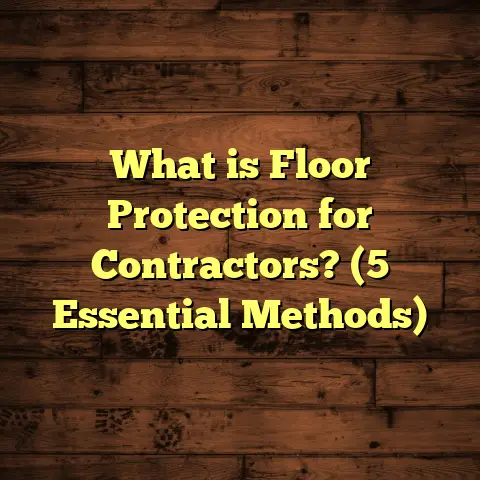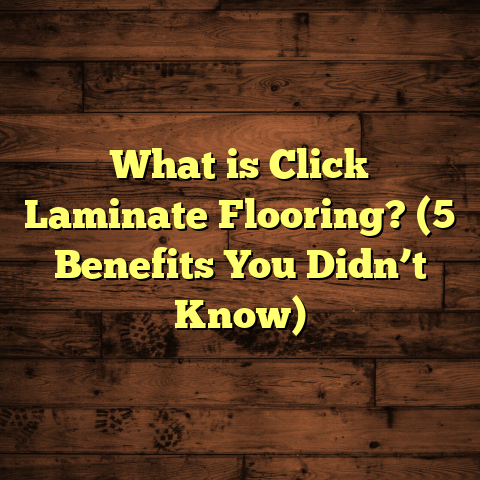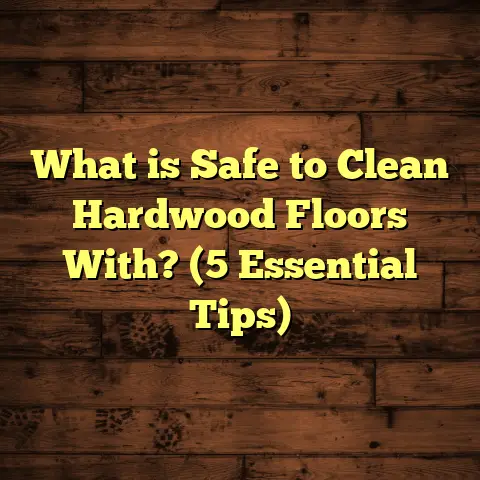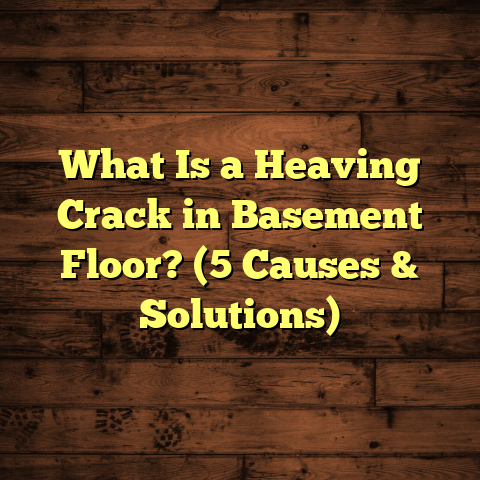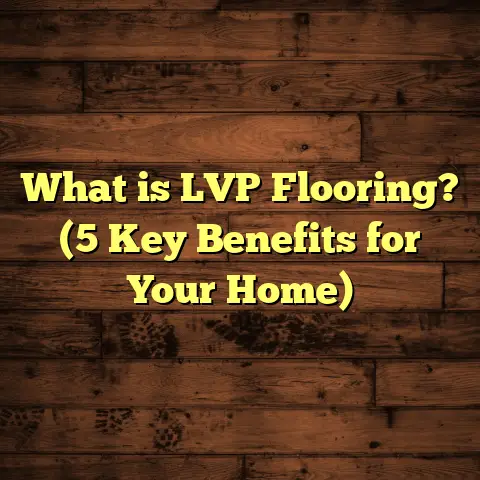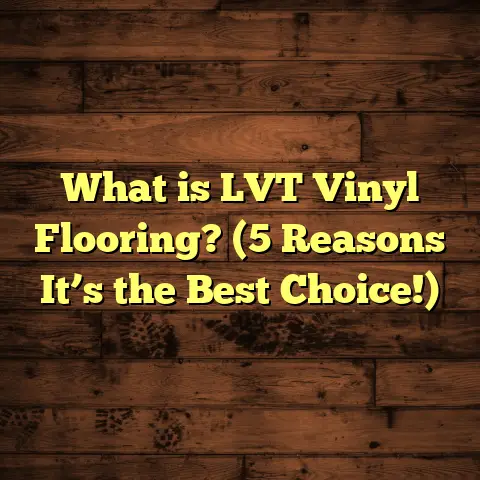What is Particle Board Flooring? (5 Facts You Must Know!)
When I think about children playing around the house, I always picture them exploring every corner, running from room to room, dropping toys, or spilling food and drinks. The floors take quite a beating. I’ve worked with many families who ask me what kind of flooring will hold up best under those conditions but still be affordable. Over time, I found that many people overlook particle board flooring as an option, or they don’t fully understand what it is. That’s why I want to share everything I’ve learned about particle board flooring — its pros, cons, and key facts you should know before choosing it for your home.
If you’re curious about particle board flooring but feel overwhelmed by all the terms and options out there, stick with me. I’ll break things down into simple pieces and even share some of my own experiences from years on the job. Let’s get into it.
What Is Particle Board Flooring?
Let’s start at the beginning: what is particle board flooring? You might have heard of particle board in furniture or cabinetry, but it’s also used in flooring — usually underneath the surface layer.
Particle board is an engineered wood product made by combining small wood particles like chips, shavings, sawdust, or even recycled wood waste with adhesives or resins. These materials are pressed together under heat and pressure to form dense sheets or panels.
It’s different from plywood, which is made by gluing together thin layers (veneers) of wood with their grains running in alternating directions. Particle board doesn’t have visible wood grain because it’s made from tiny wood bits glued indiscriminately.
Why does this matter? Because the structure impacts how strong and durable the material is, how it reacts to moisture, and how it can be used in construction.
In flooring, particle board usually acts as a subfloor or underlayment. This means it lies beneath whatever finished floor you see — hardwood, carpet, vinyl, or laminate. However, some manufacturers create laminated particle board panels that mimic finished floors for budget-conscious buyers.
What Particle Board Is Made Of
Understanding what particle board is made of helps explain its properties:
- Wood Particles: These come from small wood chips, sawmill scraps, and sometimes recycled wood fibers. The particles are usually uniform in size to ensure consistency.
- Binders and Resins: Synthetic adhesives like urea-formaldehyde or phenol-formaldehyde glue the particles together during pressing.
- Additives: Some boards have wax or other chemicals added to improve water resistance or durability.
The process involves mixing these components and pressing them into large sheets 4 feet by 8 feet (standard size) with thicknesses ranging from 1/4 inch up to 1 inch or more.
Particle Board Vs. Other Engineered Woods
People often confuse particle board with other engineered woods:
- Plywood: Thin layers of wood veneer glued with grains alternating.
- MDF (Medium-Density Fiberboard): Made from even finer wood fibers than particle board, resulting in a smoother surface.
- OSB (Oriented Strand Board): Made from larger wood strands oriented in specific directions for strength.
Particle board tends to be the least expensive but also the least moisture resistant and durable compared to these options.
Fact 1: Particle Board Flooring Is Budget-Friendly but Less Durable
One of the biggest draws of particle board is its cost. In almost every flooring project I’ve done where budget was tight, particle board was a top choice for subflooring because it’s roughly 30-50% cheaper than plywood or OSB.
To give you a concrete idea: plywood subfloor sheets can cost between $25 to $40 per 4×8 sheet depending on thickness and quality. Particle board sheets can come in at $15 to $25 for similar sizes. When you need dozens of sheets to cover a large floor area, those savings add up fast.
But here’s the catch: particle board simply doesn’t have the strength or resilience of plywood or hardwood.
What Does This Mean in Practice?
- Particle board can dent more easily if heavy furniture is dragged across it.
- It’s more prone to chipping or crumbling if mishandled during installation.
- It doesn’t hold nails or screws as securely over time because the particles don’t grip fasteners as well as solid wood fibers do.
- Over many years of wear and tear — especially if exposed to moisture — it can degrade faster.
I once worked on a renovation where a family had particle board subflooring installed under carpet. After several years, some areas started squeaking and felt spongy. They discovered that moisture from spills and humidity had caused swelling in localized spots, weakening the particle board beneath.
Strength Ratings & Data
According to information from the Composite Panel Association:
- Particle board has a compressive strength ranging approximately from 4,000 to 7,000 psi (pounds per square inch), depending on density.
- By comparison, plywood ranges higher — closer to 8,000 to 11,000 psi.
- This means plywood can bear more weight and stress before deforming.
That strength difference translates to how well floors hold up under daily use.
Fact 2: It’s Primarily Used as a Subfloor
You might be wondering: can you use particle board as your finished flooring surface? The honest answer is usually no — not by itself at least.
In most homes that I’ve worked on or inspected, particle board serves as a subfloor layer. It sits on top of floor joists and provides a level base for other flooring materials such as:
- Carpet
- Laminate
- Vinyl sheets or planks
- Engineered hardwood
- Tile (with proper underlayment)
Using particle board this way takes advantage of its affordability while protecting it with more durable surface materials that stand up better against foot traffic.
Why Not Use Particle Board as Finished Flooring?
Particle board alone isn’t attractive or strong enough for visible floors because:
- It lacks natural wood grain or texture.
- It scratches and dents easily.
- It absorbs moisture readily unless sealed.
- Its edges are fragile and prone to crumbling when exposed.
However, some companies laminate particle boards with decorative wood veneers or plastic layers that mimic hardwood or tile surfaces. These laminates give a finished look but don’t change the core weaknesses of the material underneath.
From my experience, laminated particle board floors are best suited for low-traffic areas like closets or temporary installations rather than busy family rooms or kitchens.
Fact 3: Moisture Is Particle Board’s Worst Enemy
Here’s a story I remember clearly: In one family’s basement renovation project, they chose particle board subflooring because it was within their budget. The basement was prone to humidity but didn’t have major water leaks.
A couple months after installation, a small pipe under the sink sprung a slow leak that wasn’t noticed early. The water seeped into the particle board causing swelling and warping over time. The laminate floor above started buckling and eventually had to be removed along with the damaged subfloor.
This kind of scenario is common when particle board meets moisture.
Why Does Moisture Cause Such Problems?
Particle board’s wood particles soak up water like a sponge because there are many tiny gaps between particles where liquid can penetrate.
As moisture enters:
- The particles swell unevenly.
- The adhesive bonds weaken.
- The structural integrity drops dramatically.
- Edges soften and crumble easily.
If left untreated or unprotected in damp environments (basements, bathrooms), particle board can become unusable within months.
Research data: Tests show untreated particle boards can absorb over 30% of their weight in water within hours and lose up to 40% of their strength after 48 hours submerged or exposed continuously.
How to Protect Particle Board Floors from Moisture?
If you decide to use particle board flooring components:
- Always install moisture barriers beneath the subfloor (like plastic sheeting).
- Seal edges with waterproof sealants.
- Avoid using in areas prone to frequent spills or standing water unless covered by waterproof flooring.
- Ensure good ventilation and humidity control in rooms with particle board subfloors.
Fact 4: Installing Particle Board Flooring Requires Specific Care
One thing I’ve learned working alongside various contractors is that even though particle board sheets are easier and quicker to install than plywood — thanks to their uniform thickness — they require careful handling.
Here’s what really matters during installation:
1. Surface Preparation
Make sure the joists or base below are clean, dry, and level before placing sheets. Uneven bases cause gaps or flexing that stresses the particle board.
2. Proper Fastening
Use screws instead of nails when possible — screws hold better over time. Drive fasteners flush but avoid countersinking too deep because you can weaken the panel surface.
3. Leave Expansion Gaps
Wood products expand and contract slightly with temperature changes. Leave around 1/4 inch gaps between sheets at edges and around walls so panels don’t buckle when expanding.
4. Stagger Sheet Joints
Arrange panels so end joints don’t line up adjacent across rows — this improves stability like brickwork patterns do in walls.
5. Avoid Overloading During Installation
Don’t drop heavy tools or materials directly on sheets; even though particle board feels solid initially, rough handling can cause cracks or dents that reduce lifespan.
In one job I did recently with amateur installers using particle board subfloors under laminate flooring — they skipped expansion gaps. Months later, when temperatures rose in summer, parts of the floor warped noticeably because there was no room for movement.
Fact 5: Environmental Impact Is a Mixed Bag
A topic I often discuss with clients concerned about green building is how eco-friendly particle boards are compared to solid hardwoods or plywood.
Here’s how I see it:
Positive Environmental Points
- Particle boards use wood waste that would otherwise go to landfills.
- They reduce demand for harvesting whole logs since they recycle sawmill scraps.
- Manufacturing uses less energy compared to producing solid wood panels from trees cut specifically for lumber.
Concerns About Emissions
Most particle boards use adhesives containing formaldehyde-based resins which can emit volatile organic compounds (VOCs) over time indoors. These gases impact indoor air quality and may cause irritation for sensitive individuals — especially children who spend lots of time on floors playing.
Luckily, regulations have gotten stricter:
- Many manufacturers now produce low-emission boards certified under CARB (California Air Resources Board) Phase 2 standards.
- There are formaldehyde-free options using soy-based or other natural adhesives.
If you care about indoor air quality (and if you have kids running around barefoot), look for eco-certified products specifying low VOCs or no added formaldehyde content.
Personal Stories & Case Studies From My Work
I want to share some real-life examples from my years in this business that highlight how particle board performs in different situations.
Case Study 1: Family Room Renovation With Particle Board Subfloor
A client approached me wanting new laminate flooring but needed help keeping costs low. We chose high-quality particle board subflooring under laminate planks. The client had two young kids who loved jumping around during playtime.
By carefully installing moisture barriers and sealing all edges before laying laminate, we avoided water damage over five years. The floor has held up well despite heavy use because the laminate protected the particle board beneath perfectly.
Case Study 2: Basement Flood Disaster
Another project involved a basement finishing job using particle board subflooring without adequate moisture protection. A flood damaged the area within months after completion causing swelling and crumbling subfloor panels that had to be replaced entirely along with carpet and drywall above.
This reminded me how critical moisture control is when using this material — especially underground or damp areas where water intrusion risk is high.
Case Study 3: Temporary Flooring Solution at Construction Site
I also used laminated particle board panels as temporary walkways on construction sites because they’re inexpensive and easy to lay down quickly. Though not intended for long-term use indoors, these boards tolerated moderate foot traffic well enough over several months until permanent flooring was installed.
How Does Particle Board Compare With Other Flooring Options?
Let’s look at how particle board stacks up against common alternatives:
| Flooring Material | Cost | Durability | Moisture Resistance | Installation Ease | Appearance |
|---|---|---|---|---|---|
| Particle Board | Low | Low | Poor | Easy | Low (unless laminated) |
| Plywood Subfloor | Medium | High | Better than PB | Moderate | N/A (usually subfloor) |
| Solid Hardwood | High | Very High | Moderate | Difficult | Excellent |
| Laminate (over PB) | Medium | Moderate | Moderate (waterproof versions exist) | Easy | Good |
| Vinyl Flooring | Medium | High | Excellent | Easy | Good |
| Tile | High | Very High | Excellent | Difficult | Excellent |
This chart sums up why particle boards are great for budget subfloors but rarely used alone as finished floors.
Tips If You’re Thinking About Using Particle Board Flooring
If you’re considering particle board for your project — here are some practical tips based on my experience:
- Use It Only as a Subfloor: Don’t rely on particle board as your top finish unless it’s specially laminated with protective layers.
- Choose High-Density Boards: Higher density means better strength and durability.
- Seal All Edges Thoroughly: Use waterproof sealants on edges and seams before installing finish floors above.
- Install Vapor Barriers: Prevent moisture from below by adding plastic sheeting between concrete slabs/basements and the subfloor.
- Avoid Moisture-Prone Areas: Kitchens, bathrooms, laundry rooms? Better off with plywood or cement backer boards.
- Select Low-VOC Products: If kids will spend lots of time indoors barefoot, choose eco-certified boards.
- Hire Experienced Installers: Proper fastening and expansion gaps reduce future problems.
- Inspect Regularly: Look out for signs of swelling, soft spots, or odors indicating moisture damage so you can act early.
- Consider Alternative Engineered Woods: If budget allows, OSB provides better moisture resistance; MDF offers smoother surfaces for cabinetry but not flooring.
- Factor Long-Term Costs: Initial savings on particle boards may lead to earlier replacements if damaged by moisture or wear.
How I Explain This To Homeowners With Kids
I often sit down with families worried about durability but constrained by budgets. My approach is honest but hopeful:
“You want something safe for your kids who crawl around or drop things all day long? Particle board can work well if used right — mainly under other floors like laminate or vinyl that protect it completely from spills or moisture.”
Then I ask questions like:
- How much foot traffic do you expect?
- Do you have pets that might scratch?
- Are there moisture risks like basements or bathrooms nearby?
These conversations help me tailor advice specifically for their situation instead of one-size-fits-all recommendations.
Final Thoughts From Me
Particle board flooring isn’t perfect — far from it — but it has its place as an affordable material when used wisely as part of a layered flooring system. Its biggest weaknesses are moisture sensitivity and lower durability compared to plywood or hardwoods.
I hope this gives you a solid understanding of what particle board flooring is all about so you can make informed choices for your home — especially if kids will be playing on those floors every day!
Got questions? Want tips specific to your project? Just ask — I’m here to help with anything flooring-related!
This article reflects my personal knowledge accumulated from over a decade working hands-on with various flooring materials combined with industry research and real-world case studies.
